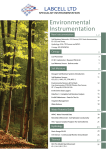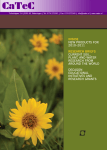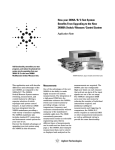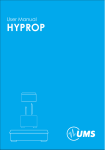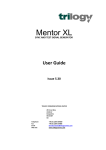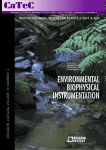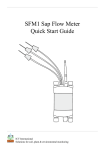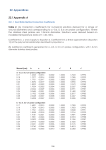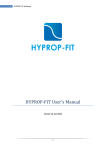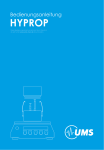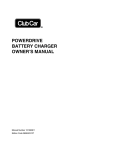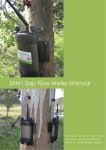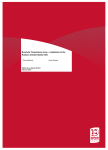Download soil moisture
Transcript
Instrumentación para Monitoreo ambiental, Fisiología vegetal y Agricultura de Precisión. Coltein Ltda. Distribuidor exclusivo para Colombia www.coltein.com www.coltein.com [email protected] new Instruments Available. Details inside. new Canopy 1 Leaf Porometer & Steady-State Technology 1 LP-80 Ceptometer: Measure PAR & LAI 3 Leaf Wetness Sensor: Built-to-order 5 Soil Moisture 7 Decagon Soil Moisture Systems Introduction 7 Soil Moisture Sensors GS3, EC-5, 10HS, 5TE, 5TM, MPS-2. 9 Environmental Sensors & ProCheck Cup Anemometer, PYR/PAR Photon Flux Sensor, RT-1, Temp RH, ECRN-50/100. 10 Em50 Series Data Loggers 11 DataTrac 3: Complete Soil Moisture Analysis 13 Em50G Webviewer: Data On The Go 14 Irrigation Management 15 Water Balance 16 Water Potential Soils 18 WP4C Water Potential Data 18 Field Water Potential Monitoring T8 Tensiometer, TS1, T4, T5/T5x, MPS-2, Infield 7 Data Collector. 19 Mini Disk Infiltrometer: Soil Hydraulic Conductivity 20 HyProp: Create SWCC Using Natural Evaporation 21 HyProp-Fit: WP Data Evaluation Software 22 VSA: Vapor Sorption Analyzer For Soil Isotherms 24 Hydrology 25 new Drain Gauge G2/G3 25 new CTD Sensor: Continuously Monitor Groundwater 28 Pore Water Samplers SK20, SIC20, SPE20. 29 Vacuum Systems 30 Thermal 31 KD2 Pro: Model Heat Movement KS-1, SH-1, RK-1, TR-1. 31 Reference Water Potential and Microorganism Growth Limits 33 Distribution and Customer Service 35 new new new new Porometer Research for Everyone High quality data without fans, tubes, or pumps. Steady State design makes accurate stomatal conductance measurements affordable and practical for everyday research. Use stomatal conductance to evaluate plant water use, quantify water stress, and compare physiological response of different varieties. Applications • Water Stress Measurements. • Variety Testing & Comparison. • Fundamental Research on Stomatal Function. • Teaching and Student Labs. Benefits • Automatic sampling mode eliminates user subjectivity. • Accurate Steady-State measurement. • No tubes, pumps, or fans. Leaf Porometer Specifications Conductance range: 0 to 1000 mmol m-2s-1. Accuracy: ±10%. Operating environment: 5 to 40ºC, 10 to 90% RH, non-condensing. Units: mmol m-2s-1, m2s mol-1, s/m. Measurement: Aperture measurement 6.3 mm. Sensor head cable length: 1.2 m (4 ft.). Measurement time in auto mode: 30 s. Power: 4 AA alkaline cells. Data storage: 4095 measurements in flash memory. learn.decagon.com/porometer Watch a 3 minute video to see how the SC-1 uses first-principle methods to measure stomatal conductance. 1 CANOPY Mathematics of the Steady State Porometer FRONT: INSIDE LOOK Decagon’s Steady State Porometer measures stomatal conductance using a sensor head with a fixed diffusion path to the leaf. It measures the vapor concentration at two different locations in the diffusion path. It computes vapor flux from the vapor concentration measurements and the known conductance of the diffusion path using the following equation: Top Leaf Rvs CVL CV1 R1 R2 CV2 Humidity Sensors Agitation Bead Where CvL is the vapor concentration at the leaf, Cv1 and Cv2 are the concentrations at the two sensor locations, RvS is the stomatal resistance, R1 is the resistance between the leaf and the first sensor, and R2 is the resistance between the two sensors. If the temperatures of the two sensors are the same, vapor concentration can be replaced with relative humidity, giving Conductance is the reciprocal of resistance, so new 2 Photosynthetically Active Radiation & Leaf Area Index. Canopy Measurements PAR/LAI Measure PAR and LAI with the AccuPar LP-80 Ceptometer. Use PAR Data to estimate biomass production without destroying the crop (see details at right). Measure photosynthetically active radiation (PAR) and get leaf area index (LAI) values simultaneously in real time. Store approximately 9000 data points manually by pressing a button or automatically in unattended sampling mode. learn.decagon.com/LP80 Watch a two minute video on measuring PAR and LAI with the AccuPar LP-80. AccuPAR LP-80 Specifications Operating environment: 0 to 5°C, 0 to 100% relative humidity. Probe length: 86.5 cm. Number of sensors: 80. Overall length: 102 cm (40.25 in). Microcontroller dimensions: 15.8 x 9.5 x 3.3 cm (6.2 x 3.75 x 1.3 in). PAR range: 0 to >2,500 µmol m-2s-1. Resolution: 1 µmol m-2s-1. Minimum spatial resolution: 1 cm. Data storage capacity: 1MB RAM, 9000 readings. Unattended logging interval: User selectable, between 1 and 60 minutes. Instrument weight: 1.22 kg (2.7 lbs). Data retrieval: Direct via RS-232 cable. Power: 4 AA Alkaline cells. External PAR sensor connector: Locking 3-pin circular connector (2 m cable). Extension cable option: 7.6 m (25 ft). Included Accessories • External PAR sensor. 2 meter cable with connector for direct connection to the ceptometer’s external port. Calibrated to provide an output of about 0.1 mV per µmol m-2s-1 (calibration label provided). • RS-232 cable. For interfacing between your computer and the AccuPAR. • Carrying case. Polyethylene hardened case with custom foam cutouts allow the instrument and its accessories to be safely stored inside. 3.6 kg, 11.8 x 24 x 109 cm. 3 CANOPY 25 20 15 Potatoes Barley 10 Apples 5 0 0.0 0.50 1.0 1.5 86.5 cm TOTAL DRY MATTER (Mg/ha) Sugar Beets INTERCEPTED SOLAR RADIATION (GJ/m2) Nondestructive Biomass Prediction The conversion of light energy and atmospheric carbon dioxide to plant biomass is fundamentally important to both agricultural and natural ecosystems. The detailed biophysical and biochemical processes by which this occurs are well understood. At a less detailed level, though, it is often useful to have a simple model that can be used to understand and analyze parts of an ecosystem. Such a model has been provided by Monteith (1977). He observed that when biomass accumulation by a plant community is plotted as a function of the accumulated solar radiation intercepted by the community, the result is a straight line. Figure 1 shows Monteith’s results. learn.decagon.com/assimilation For more information view the free virtual seminar “Model Carbon Assimilation By Plants.” 4 Built-to-order Leaf Wetness Sensor Detect leaf wetness duration with a sensitive, calibrated, standardized sensor. Many diseases affect plants only when moisture is present on the leaf surface. The Dielectric Leaf Wetness Sensor determines the presence and duration of wetness on a leaf’s surface, enabling both researchers and growers to forecast disease and protect plant canopies. The Decagon Leaf Wetness Sensor approximates the thermal mass and radiative properties of leaves to closely mimic the wetness state of a real leaf. Because the sensor does not take resistance based measurements, it requires no painting or user calibration, and has the ability to detect ice formation as well. Applications • Disease forecasting and modeling. • Ecological and agricultural research. Specifications Measurement time: 10 ms. Power: 2.5 VDC @ 10 mA to 5 VDC @ 7 mA. Output: 250 to 1500 mV. Operating environment: -20 to 60°C. Expected lifetime: 2+ years continuous use. Probe dimensions: 1.2 x 5.8 x 0.075 cm (4.4 x 2.3 x 0.029 in) Cable length: 5 m standard, custom length available. Connector type: 3.5 mm plug. Data logger compatibility: (not exclusive) – Decagon Em50, Em50R, Em50G, Campbell Scientific CR10, 10X, 21X, 23X, 1000, 3000, 5000. 5 CANOPY High resolution sensor distinguishes between frost, dew and rain. PROBE OUTPUT (RAW COUNTS) 1200 1100 1000 900 800 700 Dew Rainfall 600 500 Frost Frost 400 Wetness Threshold 300 72 72.5 73 73.5 74 74.5 75 TIME (DAYS) Because ice has a much lower dielectric content than that of liquid, the sensor output from frost will be much lower than that from a similar amount of rain or dew When read with the Em50 data logger, the LWS outputs 445 raw counts when dry. When the sensor is totally wet, as in heavy rain, the signal can range up to around 1400 counts. Varying amounts of water on the surface will cause sensor output proportional to the amount of water on the sensor’s surface. learn.decagon.com/LWS Watch a 4 minute video on the unique measuring capabilities of the Leaf Wetness Sensor. 6 Soil Moisture Systems Big Networks for Big Science. Available Sensors Data Loggers Software See the new rugged soil moisture sensor line plus standard soil moisture probes and a range of above-ground sensors. Hassle-free access to your data—set up the logger and start logging in less than 30 minutes. DataTrac 3 provides you with an almost real-time graphical picture of your data. Details on page 11 Details on page 13 n Electrical interface for all sensors: 3.5mm plug or 3-wire. n All sensors plug and log with Decagon Data Loggers. n All Sensors are compatible with most CSI Data Loggers. Call to verify compatibility. Details on page 9 7 Your soil moisture, delivered. SOIL MOISTURE 1 5 2 4 3 Image: DataTrac 3 software screenshot 1 1 KNOW Know the status of the loggers in your network. When you click on a logger in the device tree, you’ll see all of the data from the logger, the battery level, and the transmission strength. 2 MANAGE Manage your wireless network. The device tree lets you organize your loggers for quick data access. 4 CREATE Create meaningful metrics such as daily light integral and vapor pressure deficit. 3 SHARE Share data with colleagues. When you allow colleagues to subscribe to your data stream, they can view all data and download a copy for analysis. 5 LEARN Learn what’s driving changes in soil moisture by seeing all of your metrics on one graph. 8 Soil Moisture Sensors Measurement & Benefits new GS3 Volumetric Water Content, Electrical Conductivity, Dielectric Permittivity, Temperature. Range VWC: 0–100%. Apparent dielectric permittivity (εa): 1 (air) to 80. Optimized for greenhouse and nursery substrates. cm EC: ±10% from 0 to 10 dS/m, user calibration required above 10 dS/m. Temperature: -40 to 50ºC. Temperature: ±1ºC. VWC: 0–100%. VWC: ±3%, typical mineral soils up to 8 dS/m. EC-5 Volumetric Water Content. (εa): ±1 εa (unitless) from 1–40 (soil range), ±15% from 40-80. EC: 0 to 23 dS/m (bulk). Benefits: 5.5 Accuracy Benefits: VWC Rockwool: ±3% VWC, 0.5 to 8 dS/m. All purpose, least expensive soil moisture sensor. VWC Potting soil: ±3% VWC, 3 to 14 dS/m. 5c m 10HS Volumetric Water Content, Dielectric Permittivity. VWC: 0–57%. VWC: ±3%, typical mineral soils up to 8 dS/m. Benefits: Apparent dielectric permittivity (εa): 1 (air) to 50. (εa): ±1 from εa of 2 to 10. ±15 from εa of 10 to 50. VWC: 0–100%. VWC: ±3%, typical mineral soils up to 8 dS/m. Apparent dielectric permittivity (εa): 1 (air) to 80. (εa): ±1 εa (unitless) from 1–40 (soil range) ±15% from 40–80. Largest volume of influence decreases effects of heterogeneity. 10 cm 5TE Volumetric Water Content, Electrical Conductivity, Dielectric Permittivity, Temperature. 5c m 5TM VWC: 0–100%. VWC: ±3%, typical mineral soils up to 8 dS/m. Apparent dielectric permittivity (εa): 1 (air) to 80. (εa): ±1 εa (unitless) from 1–40 (soil range) ±15% from 40–80. Benefits: new Include temperature dependencies n your research study. MPS-2 Soil Matric Potential, Temperature. Benefits: 3c m 9 Temperature: ±1ºC. Temperature: -40 to 50ºC Volumetric Water Content, Dielectric Permittvity, Temperature. m Bulk EC: ±10%. Benefits: Manage salts and fertilizers in your system.dependencies in your study. 5c EC: 0 to 23 dS/m (bulk). Maintenance-free water potential and soil temperature monitoring measurements that do not drift over time. Temperature: -40 to 50ºC. Temperature: ±1ºC. Soil water potential (Ψ): -10 to -500kPa (pF 1.71 to pF 3.71). Ψ: ±25% of reading from -5 to -100 kPa* Temperature: -40°C to 50°C. Temperature: ±1ºC. *Accuracy significantly improved with custom calibration. Environmental Sensors Characterize the environment above the soil surface. The anemometer measures both wind speed (using windcups and a magnetic switch) and wind direction (with wind vane). Includes sealed stainless steel bearings for long life. The range and accuracy specifications of this unit have been verified in wind-tunnel tests (information available upon request). Resolution: 1 mph (0.45 m/s). Range: 0 to 129 mph. Accuracy: ±5%. Pyranometer Model PYR/PAR Photon Flux Sensor Completely water proof, submersible and designed for continuous outdoor use. Cable length: 1 m. Range PAR: 0 to 2000 µmol/m2s. Range PYR: 0 to 1750 Wm-2. Dimensions: 24 mm diameter, 29 mm deep. Accuracy: ±5%. RT-1 The rugged RT-1 soil temperature sensor is an easy-to-use sensor for measuring the temperature of soil or other materials. The sensor is stainless steel, completely water proof, submersible, and designed for continuous outdoor use. Resolution: 0.1°C. Range: -40 to 80°C. Temperature accuracy: ±1°C. Type: Thermistor. Output: 320–1000 mV @ 3V excitation. Temp RH ECRN-50 ECRN-100 Durable sensor measures relative humidity and temperature, and outputs both values as digital signals. Small self-emptying rain gauge for measuring irrigation events or precipitation. High-resolution rain gauge with two internal tipping spoons. Probe RH range: 0 to 100% RH. Temperature range: -40 to 60°C. Temperature accuracy: ±1°C. RH accuracy: ±2% from 10–90% RH, ±3% from 0–10% RH, and 90–100% RH. Resolution: 1 mm. Funnel size: 5x10 cm. SOIL MOISTURE Cup Anemometer Resolution: 0.2 mm. Funnel size 17x14.2 cm. ProCheck Indispensable tool for large installations. This staff favorite allows you to: • Check sensors quickly during installation. Know if the installation is good before you start backfilling. • Troubleshoot sensors in the field. • Program SDI-12 addresses. All sensors are plug-and-log with Em50 series data loggers. Details on page 11 10 Data Loggers Spend more time with your data– not your data logger. Can it really be that easy? learn.decagon.com/27minutes Specifications Watch Ross, a research associate, set up an Em50G without any preparation. Data Logger: Universal Specifications. Just plug in any Decagon sensor, set your sensor type and measurement intervals using drop down menus, and start logging data. Pre-programmed No user programming necessary. Powered by 5 AA Batteries. No external power source required. Weatherproof No extra enclosure needed. 11 Channels: 5. Interface: Each channel can accept all digital, analog, or pulse Decagon sensors. Storage: >36,000 scans, each scan includes logger name, date, time, and sensor measurements. Scan interval: User configured from 1 measurement/minute to 1 measurement/day (minimum Em50G scan interval every 5 minutes). Power: 5 AA batteries. Enclosure rating: IP55, NEMA3. Em50G Applications Cellular transmission worldwide, Direct Connect. Large-scale and small-scale studies where daily access to data is advantageous. Storage Studies with multiple researchers requiring access to the same data set. Automatic logger storage (36,000 scans), Decagon data server, Local Datatrac 3 storage with every download. SOIL MOISTURE Options Em50R WITH DATASTATION Options Applications Radio 900 MHz, Direct Connect. Small-scale (less than 2 km2) studies with a central data collection location. Storage Logger storage (36,000 scans), DataStation storage (1 MB), local DataTrac 3 storage with every download from DataStation or Direct Connect. Studies that do not have cellular coverage. Em50 Options Applications Direct Connect. Studies where data access is only necessary once or twice per year. Storage Logger storage (36,000 scans), local DataTrac 3 storage with every download. 12 Complete Soil Moisture Analysis– DataTrac 3 DataTrac 3 transforms endless columns and rows of raw data into meaningful, easily-interpreted graphs. 1 2 3 TRY IT FREE! 4 Download your Free 30-day trial. learn.decagon.com/datatrac3 6 1 Educate and inform your team efficiently. DataTrac 3’s graphics reduce the time and expertise needed to understand soil moisture data. 4 Add notes and ideas to the data stream. Comments and reminders can help you make sense of a growing season’s data later. 13 5 2 Adjust date ranges, add or subtract data from specific sensors, and change target bands to illustrate and explore your findings. 5 Automatically collect data from your Em50G and Em50R loggers. All data—including manually collected data—will be automatically organized and added to your files chronologically. 3 Watch your data in real time. DataTrac 3 updates automatically while it’s running and every time it starts up. 6 Use Growing Tools to combine data streams and track meaningful indicators. For example, plot vapor pressure deficit instead of just temperature and humidity. Or track growing degree days, plant available water, pore water EC, etc. Data On The Go Demo the free Em50G Webviewer. new SOIL MOISTURE Webviewer is free software with the following benefits: n View your Em50G data on any mobile device with internet. n Easily share up-to-date data with colleagues– no spreadsheets needed! n Check on your system anytime, anywhere. n Check most recent data and battery level from all of your loggers. n Data from the previous week is always shown on the graph for quick updates. n Share your data with anyone– without having to purchase additional software. Em50Gwebviewer.com Access to your data has never been so easy. 14 Manage Irrigation Without Leaving Your Desk See both how much water is in the soil and how much of that water is available to plants. Soil moisture sensors only measure volumetric water content. Use the matric potential sensor to monitor plant water availability. Fast-response soil moisture sensors let you track plant water use in real time and set an accurate full-point that minimizes wasted water. 1 Know when to turn the irrigation on and off with customizable target zones. 4 1 2 3 Image: DataTrac 3 software screenshot 1 2 Track water in the root zone with Decagon soil moisture sensors. Plant available water is calculated automatically with DataTrac 3’s Growing Tools option. 3 Rain gauges and irrigation pressure switch data on the same graph as soil moisture show how each event affects the water available to your plants. learn.decagon.com/vineyard See how a viticulturist uses the new features in DataTrac 3 to maximize their yield. 15 4 Focus on key stress levels with the extended range water potential sensor. Close Your Water Balance With precipitation, soil water storage, and deep drainage. Two tough components of the water balance are storage and deep percolation. Collect the data you need to calculate water input, storage, and drainage in the vadose zone. Measure deep drainage rather than estimating to reduce errors in water balance calculation. SOIL MOISTURE 7 6 5 Image: DataTrac 3 software screenshot 2 5 Quantify drainage past the root zone with the Drain Gauge G3. Water samples are also held in the Drain Gauge’s reservoir for chemical flux calculations. 6 Add local precipitation data to your calculations for water contributions to the root zone. 7 Measure soil water storage in the root zone with 5TM. Sensors can be placed throughout the soil profile to further quantify soil profile water storage. 16 17 Essential Water Potential Data Make fast, accurate water potential measurements in the lab. Measure the water potential of soil, soilless substrate, plant tissue, or any porous material in 5 to 10 minutes. The WP4C measures water potential by determining the relative humidity of the air above a sample in a closed chamber (an AOAC-approved method, conforms to ASTM 6836). Applications • Soil moisture characteristic curves. • Root zone water potential profiles. • Expansive soil characterization. • Leaf water potential. • Seed priming. • Seed water relations. Specifications New features displaying a final reading. • Speedy Equilibration—new hydrophobic teflon impregnated nickel alloy sample chamber coating reduces equilibration time. • Finely-Tuned Adjustments—new algorithms allow precision calibration and ±0.05 MPa (or better) accuracy. • Better Range and Accuracy—resolves temperatures to a thousandth of a degree to push the functional range to -0.1 MPa. 25 plastic cups and 10 stainless steel cups included WATER POTENTIAL SOILS • Precise Mode—verifies full equilibrium before Operating environment: 5 to 43°C (41 to 110°F). Temperature control: 15 to 40°C ±0.2°C. Sensors: 1. Infrared temperature 2. Chilled-mirror dewpoint. Range: 0 to -300 MPa*. Accuracy: ±0.05 MPa from 0 to -5 MPa, ±1% from -5 to -300 MPa. Read time: Typically 5 to 10 minutes. Interface cable: Serial cable (included). Data communications: RS232 compatible, 8-bit ASCII code, 9600 baud, no parity, 1 stop bit. Weight: 3.2 kg (5.2 kg shipping weight). Universal power: 110-220V AC, 50/60Hz. Sample dish capacity: 7 ml recommended (15ml full) . Calibration standard: 0.5 molal KCl (-2.22MPa). new learn.decagon.com/WP4C Watch R&D scientist Dr. Doug Cobos discuss the advancements made with the new WP4C. * WP4C will read to 0 MPa, but readings of samples wetter than -0.1 MPa will have an increasing, and typically unacceptable, percentage of error. Some users may be able to make useful measurements in samples wetter than -0.1 MPa using special techniques. For more information, see the WP4C User Manual. 18 Field Water Potential Monitoring UMS designs and T8 Tensiometer manufacturers tensiometers to make research easier. The pressure transducerbased sensors allow for precise measurement of water potential. A variety of sizes give you options for deployment from field to lab. Their newest tensiometer, the TS1, allows yearlong field deployment after installation. 2 2-2 Includes temperature measurement, 00 cm water level indicator and external refilling option. WATER POTENTIAL SOILS TS1 20- 200 cm The world’s first smart tensiometer. Designed to be deployed and left in the field, the TS1 logs water potential data, self refills, monitors temperature, and self-empties when the temperature nears freezing to avoid damage. Tensiometer Specifications Range: +100 to -85 kPa (-200 kPa T5x). Accuracy: ±0.5 kPa*. Resolution: 0.1 kPa. Hysteresis: typ. 0.1% FS. Stability over one year: typ. 0.5% FS. T4 Tensiometer 10- 200 Sensor: Piezoresistive pressure transducer, overpressure max ±3000 hPa. cm Electronics: Wheatstone full bridge. Standard tensiometer with external refilling option. Compatibility: Infield 7 and Campbell Scientific data loggers. *This range is possible with the T5x only, depending on refill. T5/T5x* 2-2 0c m Mini-tensiometers are essential for the measurement of water potential in small spaces such as soil columns, potted plants or laboratory water flow experiments. * With careful refilling the T5x can make measurements below -85 kPa. Infield 7 Handheld Digital display interfaces with all UMS tensiometers for quick data collection. new MPS-2 Specifications MPS-2 3 cm Water potential monitoring in vadose zone, crop stress, waste water drainage studies, irrigation monitoring and control, and plant water availability. 19 Length: 3 cm. Measurement: Soil matric potential. Range: ±25% of reading from -10 to -100 kPa*. Accuracy: ±25% of reading from -5 to -100 kPa. *Accuracy significantly improved with custom calibration. X Measure Soil Hydraulic Conductivity Quantify spatial variability of soil hydraulic conductivity. Bubble chamber stopper Suction regulation tube Bubble chamber Water movement in soil is spatially variable. Chamber barrier The Mini Disk Infiltrometer is a quick way to test hydraulic conductivity and infiltration rates. Backpackable Quick Setup Just fill the reservoir, set the suction, and start measuring infiltration. You don’t have to pre-saturate the disk. Straightforward Calculations Enter infiltration and elapsed time data in the included spreadsheet calculator to find hydraulic conductivity. Acrylic tube HYDROLOGY Small, compact, and simple, the Mini Disk Infiltrometer is a true field instrument. It can be tossed into a backpack with a bottle of water. Height: 32.7cm Water reservoir Mariotte tube Sintered stainless steel disc encapsulated in elastomer base Reliable Both scientists and technicians have used the Mini Disk Infiltrometer to design irrigation systems, demonstrate hydraulic conductivity, evaluate erosion hazard, and gauge the impact of forest fires. Y Specifications Total Length: 32.7 cm. Suction Range: 0.5 to 7 cm of suction. Water Volume for Operation: 135 mL. Diameter of Sintered Stainless Steel Disc: 4.5 cm diameter, 3 mm width. 20 Take a look inside HyProp HyProp Create SWCC Using Natural Evaporation. Forget the pain of using pressure plates. Use HyProp to generate detailed soil-water characteristic curves. Just take your undisturbed sample, put the sample in the instrument, insert the measurement head, place the HyProp on the balance, and in less than a week, you have a detailed moisture release curve. • Uses undisturbed soil samples. • Works in all soil types. • Bonus feature gives unsaturated hydraulic conductivity values for the soil sample. See page 22 graphic (Right) 21 Specifications Range: +2 to -120 kPa / -250 kPa. Resolution: 0.001 kPa. Accuracy: ±0.15 kPa. Optional Laboratory Scale Specifications Measuring range: 0 to 2.5 kg. Resolution: 0.01 g. Accuracy: ±0.1 g. Interface: RS232 Information Measurements Evaluation Fitting Export FIT HYDRAULIC FUNCTIONS Retention Θ (pF) Conductivity K(pF) Conductivity K(Θ) 55 40 35 30 25 20 15 LOG 10 (K in cm/d) 45 LOG 10 (K in cm/d) VOL. WATER CONTENT % 50 10 5 0 pF(–) pF(–) VOL. WATER CONTENT % Curve Drying portion of the moisture release curve generated by HyProp combined with WP4C data. Data Added data HyProp-Fit makes it easy to use the HyProp with the new WP4C to generate a complete moisture release curve and parameters for use in modeling. new Y SOILS HyProp-Fit Moisture Release Curve Software. WATER POTENTIAL SOILS Curve Fits for All Water Potential Data Put all your data together. HyProp-Fit software takes data generated by the HyProp, WP4C, tensiometer, or any other water potential instrument and creates a moisture release curve. Generate curve fits based on van Genuchten, van Genuchten Bimodal, Brooks and Corey, and other models. HyProp-Fit finds the optimal parameter sets without initial parameter guesses. learn.decagon.com/fullcurve Watch a short video on how the HyProp and WP4C work together. Free Download HyProp-Fit learn.decagon.com/hypropfit 22 23 25 Isotherm generated by the VSA Bentonite WATER CONTENT (g/100g) Palouse B 20 NM Clay Walla Walla Royal 15 L-soil 10 5 -500 -400 -300 -200 -100 0 0 WATER POTENTIAL (Mpa) Vapor Sorption Analyzer. new learn.decagon.com/VSA Watch a video on innovative ways the VSA is being used in soils applications. WATER POTENTIAL SOILS Create Static and Dynamic Isotherms Automatically Generates up to 200 data points (water potential vs. water content) for both adsorption and desorption within 24-48 hours. The VSA works in the dry (-10 to -475 MPa) range. Create automated soil-water characteristic curves and generate all the correlations with clay activity, surface area, and swelling potential. Hold humidity constant and look at the way soil takes up water into its crystal structure (2:1 clays) and monitor water content change over time. Specifications Range: -10 to -475 MPa. Accuracy: ±1 MPa or ±1%. Temperature operating range: 15 to 40°C. Size: W 25.4 x L 38.1 x H 30.5 cm (10x15x12 in.) Weight: 19 kg. Benefits • Rapid isotherm generation. • Fast expansive soil characterization. 24 Monitor Groundwater Leaching Measure Deep Percolation Rates Directly. Determine the volume of water and chemicals draining from the vadose zone into groundwater. The Drain Gauge measures drainage flux in unsaturated soils and collects soil water samples for chemical analysis. An ingenious duct and wick design maintains a flow rate within the gauge equivalent to that in surrounding soil. A surface port allows you to draw out samples to analyze for chemicals, fertilizers, and other contaminants. Applications • Waste landfill sites: advise operators when drainage is occurring and where cover systems need to be improved. • Maximization of food processing waste applications; monitoring water drainage rates and water quality below the root zone. • Environmental research; measuring percolation and recharge rates. • Farming operations: measure and control irrigation during a cropping season. • Recreational facilities (such as golf courses): measure and control excess water and nutrient losses. Drain Gauge G2 25 Drain Gauge G3 new Flow Through Technology Sample Capture Technology Inert material construction of the tube, sensors, and collection reservoir inhibits chemical reactions. Surface port provides easy access to drainage/ temperature/ EC sensor for maintenance. Measurement surface area: 324 cm2. Sampling reservoir volume: 150 mL. Accuracy: ±10%. Resolution: 0.1 mm drainage Suction at intake: 110 cm (11 kPa) Total length: 147 cm Divergence control tube (DCT) length: 60 cm. Measurement time: 10 ms. Measurement surface area: 507 cm2. Sampling reservoir volume: 3 L. Accuracy: ±10%. Resolution: 0.1 mm drainage Suction at intake: 110 cm (11 kPa) Total length: 147 cm Divergence control tube (DCT) length: 60 cm. Measurement time: 150 ms. HYDROLOGY 26 27 Measure Conductivity, Temperature, and Depth Continuously monitor groundwater and surface water level changes along with electrical conductivity and temperature. Decagon’s CTD sensor puts much of its complex circuitry in an above-ground data logger. This lowers the per-sensor cost without impacting accuracy and resolution. So instead of relying on a single measurement, you can measure in several different locations without exceeding your budget. new learn.decagon.com/CTD Watch a video to learn more about the capabilities of the CTD sensor. Specifications Electrical Conductivity Range: 0 to 120 dS/m (mS/cm). Accuracy: ±0.01 dS/m or ±10%. Resolution: 0.001 dS/m. Temperature Range: -40 to +50°C. Accuracy: ±1°C. Resolution: 0.1°C. Data Logger Compatibility Em50/Em50R/Em50G. Call for compatibility of Data Loggers. • Robust marine-grade epoxy overmold to resist corrosion in tough environments. • Compact 3.4 cm diameter sensor body to fit into tight spaces. • External logger with remote transmission option to deliver the data directly to your desktop. • Permanent connection to collect data continuously without pulling up the sensor. HYDROLOGY Water Depth Range: 0 to 3.5 m. Accuracy: ±0.2 % of span at 20˚C. Resolution: 1 mm. Features Applications • Aquifer recharge and recovery. • Saltwater intrusion, desalination, and wastewater. • Wetland monitoring. • Groundwater contamination monitoring. • Surface water monitoring. 28 Pore Water Samplers Don’t take a soil core every time you want data. Leave your experimental site undisturbed and take more meaningful pore water samples with UMS’s pore water samplers. Applications • Quantify the presence of heavy metals, pesticides, and other contaminants. • Measure net mineralization rates. • Sample for organic carbon. SPE20 Polyethylene Nylon Membrane Specially suitable for heavy metals, herbicides, and pesticides. Shaft diameter: 20 mm; acrylic. Shaft length: 20 to 210 cm; customized to order. Porous ceramic: 20 mm diameter; 60 mm length. Bubble point: -100 kPa; but the PE cover allows water flow only up to -20 kPa. Suction tube: Polyethylene; 1.6 mm i.d.; 2.8 mm o.d. SK20 Aluminum Oxide Ceramic Suitable for determination of nitrate and common organic and inorganic substances. Shaft diameter: 20 mm; acrylic. Shaft length: 20 to 210 cm; customized to order. Porous ceramic: 20 mm diameter; 60 mm length. Bubble point: -100 kPa. Suction tube: Polyethylene; 1.6 mm i.d.; 2.8 mm o.d. SIC20 Silicon Carbide Allows for sampling of a broad range of chemicals due to low sorption. Shaft diameter: 20 mm; acrylic. Shaft length: 20 to 210 cm; customized to order. Porous ceramic: 20 mm diameter; 60 mm length. Bubble point: -90 kPa. Suction Tube: Polyethylene; 1.6 mm i.d.; 2.8 mm o.d. 29 Vacuum Systems Tensiometer control ensures accurate sample concentrations. How does it work? A pore water system is a quick access point for extracting soil water. Rather than digging up a chunk of soil and performing an extraction every time you want a sample, you install a specially tipped tube in the soil. Soil water samples are gently extracted from soil pores using suction pressure matched to natural soil water tension. Soil water tension is measured with a tensiometer; suction is set slightly above that tension to pull a sample. Eliminates Spatial Variability Sampling in the same undisturbed location every time gives you better data. Uses Natural Sampling Suction Precisely controlled tension means you sample what’s actually in the soil water. Constant, unregulated tension preferentially samples the wet time periods, diluting your samples and giving inaccurate concentrations. UMS’s unique tensiometer control matches sampler suction to the natural suction of the soil as conditions change, for the most accurate sample concentrations. Customized to Solute Type UMS’s patented silicone carbide tip is inert to a large range of compounds. Other tips are also available. HYDROLOGY VacuPorter ELECTRIC PUMP Max. vacuum: -85 kPa. Max. pressure: 400 kPa. Capacity: 10 liters/min. Battery capacity: Internal rechargeable battery; 7 hours of operation. Case: 30 x 25 x 13 cm. Weight: 4.8 kg. Operating temperature: -10 to +45°C. VS/VS-Twin/VS-pro VPS-2 Power supply: 10.5 to 15 VDC. Interface: tensioLINK, RS485. Memory: 5000 readings. Vacuum regulation range: 0 to -85 kPa. Dimensions: 26 x 16 x 10 cm. Enclosure: Aluminum. Operating temperature: -10 to +45°C. Max. vacuum: -85 kPa. Capacity: 0.41 liters per stroke. Material: Aluminum and stainless steel, steel foot. Height: 57 cm Weight: 2.2 kg. Hand-Operated Floor Pump 30 Model Heat Movement Get A Handle On Heat Transfer. Each KD2 Pro comes factory calibrated and includes performance verification standards. Measure heat transfer in the soil plant atmosphere continuum with the KD2 Pro Thermal Properties Analyzer. The KD2 Pro has three interchangeable sensors which measure thermal conductivity, thermal diffusivity and specific heat (heat capacity) along with data storage capabilities and an automatic data collection mode. The optional RK-1 sensor kit measures rock, concrete and other materials where drilling a pilot hole is required. KS-1 6 cm needle length • Heated Needle Technology. • Requires No Calibration. • Displays in Engineering Units. • Small Needle Minimizes Soil Disturbance. SH-1 Specifications: 3 cm dual needle length Measurement time: 90 Seconds to 10 minutes. Accuracy*: ± 5 to ± 10% Conductivity/Resistivity. ± 10% Thermal Diffusivity, ± 10% Specific Heat. Ranges*: K: 0.02 to 4 Wm-1 C-1, D: 0.1 to 1.0 mm2s-1, R: 0.5 to 50 mC W-1, C: 0.5 to 4 MJ m-3 C-1. Data storage: 4095 readings. Environment: –50 to 150°C. Case size: 15.5 x 9.5 x 3.5 cm. Power: 4 AA Batteries. Cable: 1 m. Thermal conductivity of liquids. 3 parameters: thermal conductivity, thermal diffusivity, and specific heat. new RK-1 6 cm needle length Thermal conductivity/resistivity; for use with stone or cement samples. *Accuracy and measurement range vary with sensor type. learn.decagon.com/KD2pro TR-1 10 cm needle length Thermal conductivity or thermal resistivity of soil or porous materials. ASTM and IEEE compliant. 31 Watch a three and a half minute video about measuring soil thermal conductivity with the KD2 Pro. THERMAL 32 Water Potential INSTRUMENT RANGES FIELD INSTRUMENTS LABORATORY INSTRUMENTS STUDY Pressure Plate* HyProp MEASURE Tensiometer Soil Water & Flow Granular Matric -10 kPa -100 kPa Plant Available Water Plant Water Studies Ecological Studies Irrigation Management MPS-2 Hypoxia -1 kPa -1 MPa Permanent Wilting Point (-1.5 MPa) Air Dry Expansive Soils -10 MPa Heat Dissipation -100 MPa WP4C DewPoint Excellent accuracy. Good accuracy. Moderate accuracy. Responds to change, may not be accurate. Useful in some applications. Not recommended or out of range. *Assumes equilibrium time 1-3 months. 33 -1000 MPa Oven Dry VSA Growth Limits pF* MPa WATER POTENTIAL aW WATER ACTIVITY MICROORGANISMS Zoospore movement ceases 2.7 -0.05 0.9996 Motility of bacteria ceases 3.2 -0.14 0.9990 Mean minimum to support bacterial growth 3.9 -0.70 0.9949 Lower limit of plant available water 4.2 -1.50 0.9891 Microcoleus growth inhibited 4.3 -1.80 0.9869 Microcoleus photosynthesis inhibited 4.5 -2.80 0.9798 Nitrification and sulphur oxidation cease 4.6 -4.20 0.9698 Bacterial respiration ceases 4.7 -5.00 0.9642 Pseudomonas etc. inhibited 4.9 -7.03 0.9500 Salmonella, some molds inhibited 5.1 -12.92 0.9100 Many yeasts inhibited 5.3 -19.08 0.8700 5.5 -30.57 0.8000 Most halophitic bacteria inhibited 5.6 -39.41 0.7500 Xerophilic molds inhibited 5.8 -59.02 0.6500 All microbial proliferation ceases 5.9 -69.98 0.6000 Most molds inhibited The biological limits are taken from L.R. Beuchat, Cereal Foods World, 26:345 (1981) and M. Potts, Microbiological Reviews, 58:768 (1994). *pF is the base 10 logarithm of the water potential in cm 34 Distributors AFRICA AUSTRALIA & NEW ZEALAND South Africa CS Africa Tel: 27 21 880 1252 [email protected] www.csafrica.co.za Australia ICT International Pty. Ltd. Tel: 61 267 726 770 [email protected] www.ictinternational.com.au Morocco METAGRYD Tel: 212 522 254 900 [email protected] www.metagrhyd.com EUROPE ASIA China Ecotek Tel: 86 10 51 665 551 [email protected] www.ecotek.com.cn India Nu-Tech International Tel: 91-11-5467218 [email protected] www.nutechintl.com Japan AINEX Co., Ltd. Tel: 81 3 5713-0388 [email protected] www.ai-nex.co.jp Korea C&H Tel: 82 2 501 3869 [email protected] www.candh.net Malaysia TMS Tel: 603-5122-5108 [email protected] www.tms-lab.com Russia Lab Depot Corporation Tel: 7 812 -320-60-48 [email protected] www.labdepot.ru Taiwan Wilson Scientific Co. Ltd. Tel: 886 2 2690 7696 [email protected] Thailand Win Siam Co., Ltd. tel. 66 2910 9898 [email protected] www.winsiam.com 35 Italy Misure SNC Tel: 39 06 907 5535 [email protected] www.misure.net Netherlands CaTeC Tel: 31 174-272330 [email protected] www.catec.nl Austria UMS GmbH München Tel: 49 89 1266 52 14 [email protected] [email protected] www.ums-muc.de Poland Geomor-Technik Sp. Z O.O Tel: 48 91 482 00 90 [email protected] www.geomor.com.pl Belgium/Luxembourg CaTeC Tel: 31 174 272 330 [email protected] www.catec.nl Romania SC Terra Preta SRL Tel: 40 746 020249 [email protected] www.terra-preta.ro Czech and Slovak Republics Ekotechnika Spol. S.R.O. Tel: 420 737 044 323 [email protected] www.ekotechnika.cz Russia Lab Depot Corporation Tel: 7 812 -320-60-48 [email protected] www.labdepot.ru Denmark Inverva ApS Tel: 45 6595 9454 [email protected] www.inverva.com Spain Centro De Asesoría Dr. Ferrer, S.L. Tel: 34 93 371 05 16 [email protected] www.lab-ferrer.com France Sols Mesures Tel: 33 1 30 503 450 [email protected] www.sols-mesures.com Germany UMS GmbH München Tel: 49 89 1266 52 14 [email protected] www.ums-muc.de Greece Scientact SA Tel: 30 2310 946 126 [email protected] www.scientact.com.gr Iceland Measurement Systems Tel: 354 661 1169 [email protected] www.maelibunadur.is Sweden Toragon AB Tel: 46 (0)90-100 260 [email protected] www.toragon.se Turkey Bilmar Tel: 0312-468 28 35 [email protected] www.bilmar.com.tr United Kingdom Labcell Ltd. Tel: 01420 568 150 [email protected] www.labcell.com MIDDLE EAST Israel Meteo-Tech Tel: 97 2 3 616 0598 [email protected] www.meteo-tech.co.il Support & Service 509-332-5600 [email protected] Turkey Bilmar Bilimsel Arastirma ve Mühendislik A.S. Tel: 0312-468 28 35 [email protected] Chile MorpH2O L.A. Tel/fax (56 2) 821 6095 www.morph2ola.com [email protected] Middle East/North Africa ICT Intl. Middle East Tel: 962 7770 54400 [email protected] Colombia Coltein Ltda. Tel: (571) 347 2038 [email protected] www.coltein.com NORTH AMERICA Canada Hoskin Scientific Ltd. (West) Tel: (604) 872-7894 [email protected] www.hoskin.ca Peru MorpH2O L.A. Tel: (56 2) 821 6095 www.morph2ola.com [email protected] Todd VANEK CUSTOMER SUPPORT MANAGER Troubleshooting, Care and Maintenance, Research Design & Data Analysis, Measurement Procedures Hoskin Scientific Ltd. (East) Tel: (905) 333-5510 [email protected] www.hoskin.ca Hoskin Scientififique Ltee. (Quebec) Tel: (514) 735-5267 [email protected] www.hoskin.ca Mexico Ruber Eim De México Tel: 52 55 5653 3077 [email protected] www.rubereimdemexico.com USA & All others Decagon Devices, Inc. Tel: 509 332 2756 [email protected] www.decagon.com SOUTH AMERICA Argentina Instrumentos del Sur S.A. Tel: 54 11 4791–0169 [email protected] www.idelsur.com Nick MOWER SALES AND SERVICE New Instrument & accessories sales, measurement procedures, general inquiries Jordan TANASSE CANOPY PRODUCTS MANAGER Troubleshooting, Care and Maintenance, Research Design & Data Analysis, Measurement Procedures Brazil Decagon Devices LatAm Ltda. Tel: 55 12 3307 1003 [email protected] www.decagon.com.br Central America LAPACA Tel: (506) 8891-9895 www.lapacacr.com Chris CHAMBERS ENVIRONMENTAL APPLICATIONS SCIENTIST Troubleshooting & measurement procedures, Research Design, Data Analysis DECAGON DEVICES, INC. Data collected with pencils processed with slide rules. Late 70’s Campbell Scientific develops inexpensive, portable battery operated data loggers. Researchers no longer need a camp trailer and extension cords to record data. TDR revolutionizes soil moisture measurements 1950’s 1976 1979 Communications-ready loggers and low cost soil moisture sensors make networks of 50, 100, even 1000 sensor points possible. 2012-PRESENT O ne of my hobbies is collecting antiques. It’s an interesting hobby for someone whose day job is all about innovation. Though I spend most of my time talking about what’s new, I also enjoy looking back. 2012 marks Decagon’s 30th anniversary and it’s made me think about the progress in measuring the environment over the last 30 years. I think there are three instrument-related developments that have advanced environmental science: • Small, low-power data loggers with wireless communication capabilities. • Significant increases in computer processing power and speed. • Dielectric soil moisture sensors (TDR, FDR). These developments make it possible to scatter collection nodes across the landscape. Researchers can now gather and analyze staggering amounts of data. Projects like B2 Landscape Evolution Observatory at Biosphere 2 and the Site-Specific Climate Friendly Farming project at Cook Farm are beginning to show us what’s possible with these big networks. What’s next? It’s impossible to say, of course, but I’m excited to see what new measurements will move the science forward. EC measurements, for example, are still somewhat crude but show promise in refining the way we look at water and nutrient movement in soils Decagon Devices, Inc. 2365 NE Hopkins Court Pullman, WA 99163 1-509-332-5600 [email protected] Bryan Wacker VICE-PRESIDENT MARKETING ©2012 Decagon Devices, Inc. PRINTED IN THE USA learn.decagon.com








































